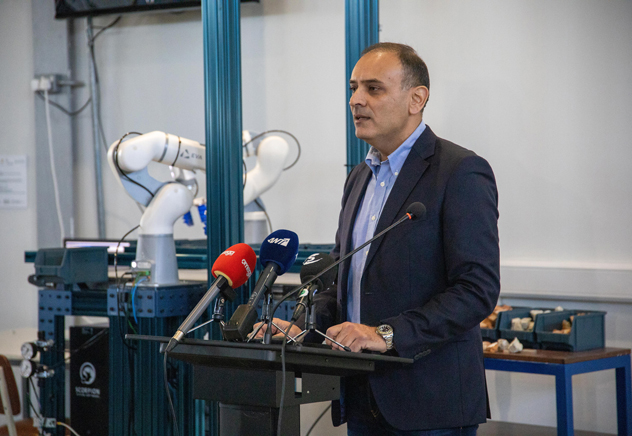
Demonstration of an innovative automated construction and demolition waste sorting prototype

An automated method for sorting construction and demolition waste (CDW) was developed by researchers working on the DEFEAT project, an EU-funded project coordinated by Frederick Research Center (FRC). Artificial Intelligence and Image Processing is applied in this automated CDW sorting prototype which was presented during a workshop on Friday, February 17th in the presence of Minister of Agricultural, Rural Development and Environment Costas Kadis. Congratulating the scientific team, the minister noted that even in high-end CDW units, waste sorting is manually implemented, lacking the cutting-edge technologies incorporated in the DEFEAT project's prototype.
Project coordinator FRC's partners in the project are the Environment Department, the Federation of Building Contractors Associations of Cyprus, the University of Cyprus and several other private bodies. Minister Kadis highlighted the importance of such cooperation among the state and academia for the transfer of knowledge.
Dr. Demetris Nicolaides, Associate Professor at Frederick University's Department of Civil Engineering and coordinator of the DEFEAT project, welcomed the guests and presented the methodological approach applied for the design and implementation of the robotic separation method of the Construction and Demolition Waste (CDW).
Dr. Pavlos Mavrommatides, Lecturer at the Department of Electrical Engineering and Researcher at FRC, analysed the implementation process of the automated CDW sorting system while Dr. Demetris Demetriou, Researcher at the University of Cyprus, explained the application process of Artificial Intelligence and Image Processing technologies.
The DEFEAT Project (INTEGRATED/0918/0052) has been co-funded by the European Regional Development Fund (ERDF) and the Cyprus Government, through the RESTART 2016-20 framework program of the Research & Innovation Foundation.
DEFEAT Project
Construction and Demolition Waste (CDW) approximately represent one-third of the total waste generated by economic activities and households, which in EU-28 are about 2.5-3.0 billion tonnes per year. In several publications, it is reported that the Construction and Demolition Waste generation amount has increased by an impressive percentage of 300% between the years 2003 – 2013. In Cyprus, the management of CDW appears to be underperforming, despite the fact that a comprehensive legislative framework concerning their management is in place since 2011.
In addition, over the last decade, the construction activities in Europe were accelerated, as well as the rehabilitation activities for energy saving, as a general need to facilitate accommodation. According to a study carried out by the European Union, the high rate of household energy consumption over the past twenty years (250-300 Mtoe) is attributed to building requirements for heating, cooling, and ventilation, due to unsatisfactory thermal insulation.
Further, only in recent years has the safety of such infrastructures gained increasing attention, particularly the issue of fire. This transformation in the mentality is attributed to a series of large fires that have taken place in the last years, which led to human casualties, major structural damages, and serious consequences for the regional economies. It has been reported that fire incidents in Europe have increased by a tragic percentage of more than 300% between the years 2010 – 2015. At the same time, the current market thermal insulation solutions consist of materials that are either combustible or undergo spalling phenomena in case of fire incidents, materials that have a high cost, or materials, the production of which results in high environmental impact.
The DEFEAT project tackles the above-mentioned barriers by developing on a pilot scale, and through detailed experimental study, an innovative separation method of CDW, as well as a composite material generated also from the CDW, which has low thermal conductivity, satisfactory mechanical properties, and at the same time is fire resistant. The produced material can be applied as a façade, either on existing or new construction projects.

